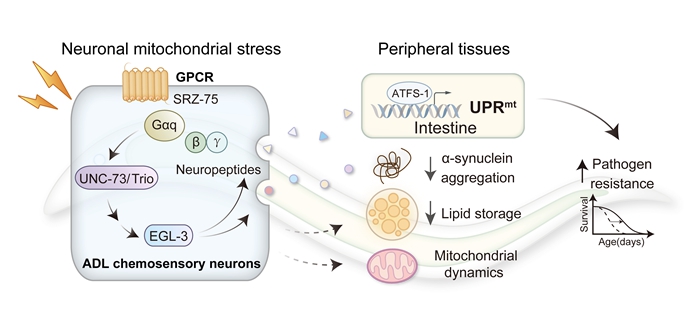The nervous system is essential for coordinating the organismal stress response. Neurons with mitochondrial stresses could release signals and communicate with the peripheral tissues to activate the organismal-wide mitochondrial unfolded protein response (UPRmt) for fitness adaptation. GPCRs play important role in transmitting various extracellular signals into cells, and have been considered one of the largest families of validated drug targets. However, whether GPCR signaling is required for coordinating inter-tissue mitochondrial stress communication remains largely unknown.
Dr.
TIAN Ye's group from the Institute of Genetics and Developmental Biology, Chinese Academy of Sciences, revealed that GPCR signaling is critical for coordinating the intestinal UPR
mt activation in response to neuronal mitochondrial perturbations in
Caenorhabditis elegans. In this study, the researchers identified that a GPCR SRZ-75 is expressed in a pair of ADL neurons and mediates the neuronal-to-intestinal UPR
mt communication. SRZ-75 couples with its downstream Gαq signaling to promote the release of neuropeptides from ADL neurons to propagate the cell non-autonomous mitochondrial stress activation.
Ablation of ADL neurons strongly attenuated the intestinal UPRmt activation in response to neuronal mitochondrial stresses. Enhanced GPCR/SRZ-75-Gαq signaling in ADL neurons induced the intestinal UPRmt activation and subsequently enhanced host resistance to Pseudomonas aeruginosa (PA14). Enhanced ADL-GPCR SRZ-75-Gαq signaling also improved proteostasis, altered mitochondrial morphology, and changed lipid metabolism in peripheral tissues.
In summary, this work provides mechanistic insights into neuronal GPCR signaling coordinating the systemic mitochondrial stress response. More importantly, activation of GPCR and downstream signaling in just two ADL neurons altered various distinct physiological characteristics in distal tissues, including an altered metabolic state, improved proteostasis and increased stress resistance.
This cover study entitled “Two sensory neurons coordinate the systemic mitochondrial stress response via GPCR signaling in C. elegans” was published online in Developmental Cell(https://doi.org/10.1016/j.devcel.2022.10.001)on October 28th, 2022.
This work was supported by the National Key R&D program of China, the National Natural Science Foundation of China, the Strategic Priority Research Program of the Chinese Academy of Sciences, and the CAS Project for Young Scientists in Basic Research.
Model for ADL chemosensory neurons coordinating the systemic mitochondrial stress response via GPCR signaling (Image by IGDB)
Contact:
Dr. TIAN Ye
Institute of Genetics and Developmental Biology, the Chinese Academy of Sciences
 Model for ADL chemosensory neurons coordinating the systemic mitochondrial stress response via GPCR signaling (Image by IGDB)Contact:Dr. TIAN YeInstitute of Genetics and Developmental Biology, the Chinese Academy of SciencesEmail: ytian@genetics.ac.cn
Model for ADL chemosensory neurons coordinating the systemic mitochondrial stress response via GPCR signaling (Image by IGDB)Contact:Dr. TIAN YeInstitute of Genetics and Developmental Biology, the Chinese Academy of SciencesEmail: ytian@genetics.ac.cn CAS
CAS
 中文
中文




.png)
